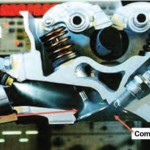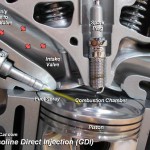This is a topic that we have addressed in a previous blog but we thought we might revisit the concept today as we are beginning to see a fair share of these vehicles on the road today along with the maintenance issues that go with these cars. According to energy.gov the market share of these cars has reached 38%. http://energy.gov/eere/vehicles/fact-869-april-20-2015-gasoline-direct-injection-captures-38-market-share-just-seven
Gasoline direct injection or GDI is a method of directly injecting the fuel mixture into the combustion chamber via an injector under high pressure. Previously the fuel mixture was injected behind the intake valve which had to open and let the mixture in. In a GDI vehicle the mixture is “ramped up” to a very high pressure by means of a special high pressure pump usually in the engine compartment much like a diesel injection pump. This allows the fuel to atomize more effectively and thereby making the whole combustion process more efficient resulting in better mileage, more power and lower emissions.
The one downside to this technology is carbon build up on the intake valves and in the combustion chamber. Some manufacturers such as BMW and Mini have addressed this by developing a chemical that will clean the carbon from these areas. We have teamed up with a company called BG which has also developed a chemical and a process for cleaning and maintaining the intake system and combustion chamber. Regular intervals of service of around 40k miles will keep the system from getting too carboned up and causing misfire codes as a result.
Check with your service professional and see if they can provide this service. It will pay you back in performance and mileage.



0 Comments